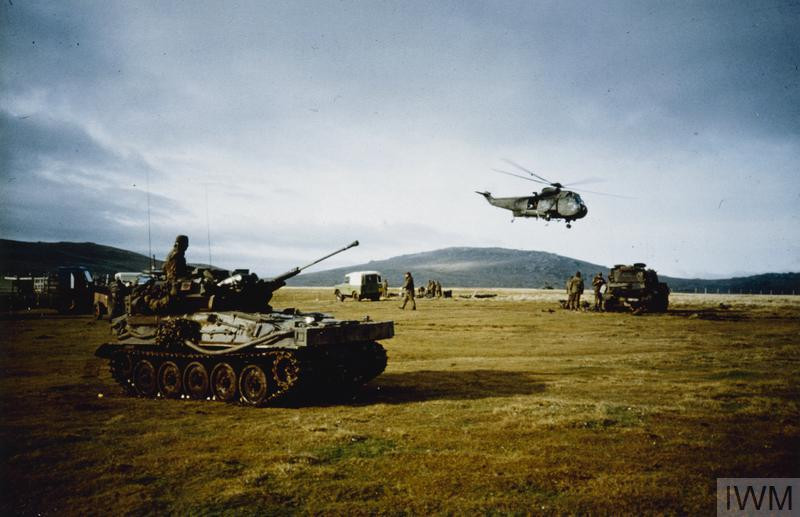Tuesday 1 June 1982 was the first of a few relatively-routine days for British forces in the Falkland Islands area of operations, although that is not to say they were without incident or even loss.
The time was spent in setting up the preferred plan for the retaking of Stanley from its Argentine defenders, which would be a two-pronged advance from north and south.
Teal Inlet to the north-west of Stanley was already being built up into a fully-fledged forward operating base, with various vessels shuttling supplies round from the San Carlos Water beachhead nightly.
By way of example, a Landing Craft Utility (LCU) from assault ship HMS Intrepid delivered around 100 tons of supplies on one run at the beginning of June, while two LCVPs (Landing Craft Vehicles and Personnel) from the same ship spent several days using a ‘bespoke’ minesweeping system to check the extensive waters of Teal Inlet.
Round at San Carlos Water the first elements of 5th Infantry Brigade began to arrive at the beachhead.
North Sea roll-on, roll-off ferry MV Norland landed Gurkhas using LCUs as most of the helicopters used to transport 3 Cdo Bde ashore a few days earlier were now busy supporting the advancing Royal Marines and Paras.
The 18,000-ton MS Baltic Ferry brought with her around 100 troops, almost 2,000 tons of stores and ammunition and three Army Scout helicopters which were unloaded in Ajax Bay, while MV Atlantic Causeway, sister ship of Atlantic Conveyor, which had finally sunk just days earlier following the devastating Exocet attack of 25 May, brought Sea Kings of 825 Naval Air Squadron and Wessex helicopters of 847 NAS.
As these stores were unloaded, work was continuing on the construction of a makeshift airfield from which Sea Harriers could operate, greatly increasing their time on patrol where they were needed, rather than spending valuable time flying back and forth to the carriers far out on the edge of the Total Exclusion Zone to the east.
The paratroopers of 3 Parachute Brigade, having captured and established themselves at Estancia House overnight, were digging in around Mount Estancia, near Mount Kent to the west of Stanley, on 1 June.
Meanwhile the new Commanding Officer of 2 Para was making an eye-catching entrance to the Conflict.
Lt Col David Chaundler, who succeeded Col H Jones VC, parachuted into the sea with a small group of colleagues from an extended-range C-130 Hercules and was picked up by frigate HMS Penelope.
Two aircraft were lost on 1 June, one from each side.
The ill-fated British aircraft was a Sea Harrier of 809 Naval Air Squadron which was hit by a Roland surface-to-air missile in the afternoon while returning to HMS Invincible after a reconnaissance flight over Stanley.
The pilot survived, but spent some 10-11 hours in the water before a rescue could be carried out under cover of darkness – the officer had landed in the sea too close to Argentine positions to make a search-and-rescue mission possible during daylight hours.
The Argentine loss earlier the same day was the C-130 Hercules that had been pestering British forces on its reconnaissance flights for some time.
On 1 June it showed up on the radar screens on board frigate HMS Minerva, and a Combat Air Patrol of two Sea Harriers was vectored in on the aircraft.
Although they were low on fuel, the Sea Harriers of 801 Naval Air Squadron took up the chase, and one caught the Hercules with both Sidewinder missile and cannon fire, destroying the aircraft 50 miles to the north of Pebble Island and killing all seven of its crew.
The Sea Harriers barely made it back to the Carrier Battle Group as they were so low on fuel, further justifying the construction of the airfield at San Carlos Water.
A third aircraft could have also been brought down on that Tuesday – an Argentine Boeing 707 was spotted on the radar of destroyer HMS Antrim as it attempted to take a look at what was happening in South Georgia, the British forces’ main marshalling area in the South Atlantic, but it did not come within range of the ship’s Sea Dart missiles.
P&O liner Canberra, taken up as a troopship during the Conflict, made her way back to the relative safety of the carrier Battle Group on 1 June after having been into Falkland Sound and San Carlos Water for the transfer of troops and equipment ashore
Today’s image from the Imperial War Museum collection (IWM FKD 2759) shows activity at Estancia House during its occupation by 3 Battalion, Parachute Regiment at the beginning of June 1982. Scimitar tanks, Sea King helicopters and civilian transport can be seen in the foreground, with Mount Kent in the centre background.
.
* These posts can only give a brief sense of what was a complex and fast-moving situation 40 years ago, and cannot cover the involvement of every ship, squadron and unit in detail – for a much more comprehensive account see the Falklands section of naval-history.net at https://www.naval-history.net/NAVAL1982FALKLANDS.htm
The Royal Naval Association is the biggest collective group of Royal Naval veterans and serving personnel, with more than 270 branches in the UK and overseas.
The RNA provides those with a link to the Royal Navy access to a life-long community of like-minded and supportive individuals.
Our community provides companionship, resilience, comradeship and unity to anyone and everyone with a Naval story, supporting them through life's highs and lows.
Membership is now free (please note, some branches may charge a small annual subscription, payable locally on their request) – see https://royal-naval-association.co.uk/join-us/ for details of how to join.
